County-Level Cultivated Land Quality Evaluation Using Multi-Temporal Remote Sensing and Machine Learning Models: From the Perspective of National Standard
Abstract
1. Introduction
2. Materials and Methods
2.1. Study Area
2.2. Data Resources and Processing
2.2.1. Soil Sampling Data
2.2.2. Satellite Data
2.2.3. Other Auxiliary Data
2.3. Methodological Framework for CLQ Evaluation
2.3.1. Construction of CLQ Evaluation System
CLQ Evaluation Indicators and Weight Coefficients
Determination of Membership Degrees of CLQ Evaluation Indicators
Calculation and Grade Division of CLQ Index
2.3.2. Prediction Model of CLQ Evaluation Indicator
Selection of Environmental Variables
Machine Learning Models
Model Training and Validation
2.3.3. Obstacle Factor Diagnosis Model
2.3.4. Validation and Comparison
3. Results
3.1. Accuracy Evaluation of Machine Learning Model
3.2. Correlation between CLQ and Crop Yield
3.3. Spatial Patterns of CLQ
3.4. Obstacle Factors of CLQ
4. Discussion
4.1. CLQ Evaluation System Based on National Standard
4.2. CLQ Evaluation Method Based on Multi-Temporal Remote Sensing and Machine Learning Models
4.3. Improving Measures and Policy Implications of CLQ
4.4. Limitations and Future Work
5. Conclusions
Author Contributions
Funding
Data Availability Statement
Acknowledgments
Conflicts of Interest
References
- Foley, J.A.; Ramankutty, N.; Brauman, K.A.; Cassidy, E.S.; Gerber, J.S.; Johnston, M.; Mueller, N.D.; Ray, D.K.; West, P.C.; Balzer, C. Solutions for a cultivated planet. Nature 2011, 478, 337. [Google Scholar] [CrossRef] [PubMed]
- Zhao, C.; Zhou, Y.; Jiang, J.H.; Xiao, P.N.; Wu, H. Spatial characteristics of cultivated land quality accounting for ecological environmental condition: A case study in hilly area of northern Hubei province, China. Sci. Total Environ. 2021, 774, 145765. [Google Scholar] [CrossRef]
- Morri, E.; Santolini, R. Ecosystem services valuation for the sustainable land use management by nature-based solution (NbS) in the common agricultural policy actions: A case study on the foglia river basin (marche region, Italy). Land 2022, 11, 57. [Google Scholar] [CrossRef]
- Song, W.; Zhang, H.Z.; Zhao, R.; Wu, K.N.; Li, X.J.; Niu, B.B.; Li, J.Y. Study on cultivated land quality evaluation from the perspective of farmland ecosystems. Ecol. Indic. 2022, 139, 108959. [Google Scholar] [CrossRef]
- Kong, X.B. China must protect high-quality arable land. Nature 2014, 506, 7. [Google Scholar] [CrossRef]
- Li, W.; Wang, D.; Li, Y.; Zhu, Y.; Wang, J.; Ma, J. A multi-faceted, location-specific assessment of land degradation threats to peri-urban agriculture at a traditional grain base in northeastern China. J. Environ. Manag. 2020, 271, 111000. [Google Scholar] [CrossRef]
- Viana, C.M.; Freire, D.; Abrantes, P.; Rocha, J.; Pereira, P. Agricultural land systems importance for supporting food security and sustainable development goals: A systematic review. Sci. Total Environ. 2022, 806, 150718. [Google Scholar] [CrossRef]
- Shi, Y.Y.; Duan, W.K.; Fleskens, L.; Li, M.; Hao, J.M. Study on evaluation of regional cultivated land quality based on resource asset-capital attributes and its spatial mechanism. Appl. Geogr. 2020, 125, 102284. [Google Scholar] [CrossRef]
- Gong, Y.; Zhang, Y.; Chen, Y. The impact of high-standard farmland construction policy on grain quality from the perspectives of technology adoption and cultivated land quality. Agriculture 2023, 13, 1702. [Google Scholar] [CrossRef]
- Liu, L.M.; Zhou, D.; Chang, X.; Lin, Z.L. A new grading system for evaluating China’s cultivated land quality. Land Degrad. Dev. 2020, 31, 1482–1501. [Google Scholar] [CrossRef]
- Liu, H.; Wang, Y.; Sang, L.; Zhao, C.; Hu, T.; Liu, H.; Zhang, Z.; Wang, S.; Miao, S.; Ju, Z. Evaluation of spatiotemporal changes in cropland quantity and quality with multi-source remote sensing. Land 2023, 12, 1764. [Google Scholar] [CrossRef]
- Kang, L.; Zhao, R.; Wu, K.; Huang, Q.; Zhang, S. Impacts of farming layer constructions on cultivated land quality under the cultivated land balance policy. Agronomy 2021, 11, 2403. [Google Scholar] [CrossRef]
- Miao, X.R.; Li, Z.H.; Wang, M.Y.; Mei, J.; Chen, J. Measurement of cultivated land ecosystem resilience in black soil region of Northeast China under the background of cultivated land protection policy in China: Case study of Qiqihar City. J. Clean. Prod. 2024, 434, 140141. [Google Scholar] [CrossRef]
- Ye, S.J.; Ren, S.Y.; Song, C.Q.; Du, Z.B.; Wang, K.X.; Du, B.; Cheng, F.; Zhu, D.H. Spatial pattern of cultivated land fragmentation in mainland China: Characteristics, dominant factors, and countermeasures. Land Use Policy 2024, 139, 107070. [Google Scholar] [CrossRef]
- Wang, N.; Zu, J.; Li, M.; Zhang, J.Y.; Hao, J.M. Spatial zoning of cultivated land in Shandong province based on the trinity of quantity, quality, and ecology. Sustainability 2020, 12, 1849. [Google Scholar] [CrossRef]
- Li, Q.; Guo, W.; Sun, X.; Yang, A.; Qu, S.; Chi, W. The differentiation in cultivated land quality between modern agricultural areas and traditional agricultural areas: Evidence from Northeast China. Land 2021, 10, 842. [Google Scholar] [CrossRef]
- Chen, Y.; Zhu, M.; Lu, J.; Zhou, Q.; Ma, W. Evaluation of ecological city and analysis of obstacle factors under the background of high-quality development: Taking cities in the Yellow River Basin as examples. Ecol. Indic. 2020, 118, 106771. [Google Scholar] [CrossRef]
- Tang, M.M.; Wang, C.T.; Ying, C.Y.; Mei, S.; Tong, T.; Ma, Y.H.; Wang, Q. Research on cultivated land quality restriction factors based on cultivated land quality level evaluation. Sustainability 2023, 15, 7567. [Google Scholar] [CrossRef]
- Duan, D.D.; Sun, X.; Liang, S.F.; Sun, J.; Fan, L.L.; Chen, H.; Xia, L.; Zhao, F.; Yang, W.Q.; Yang, P. Spatiotemporal patterns of cultivated land quality integrated with multi-source remote sensing: A case study of Guangzhou, China. Remote Sens. 2022, 14, 1250. [Google Scholar] [CrossRef]
- Sun, X.; Li, Q.; Kong, X.; Cai, W.; Zhang, B.; Lei, M. Spatial characteristics and obstacle factors of cultivated land quality in an intensive agricultural region of the North China Plain. Land 2023, 12, 1552. [Google Scholar] [CrossRef]
- Mamehpour, N.; Rezapour, S.; Ghaemian, N. Quantitative assessment of soil quality indices for urban croplands in acalcareous semi-arid ecosystem. Geoderma 2021, 382, 114781. [Google Scholar] [CrossRef]
- Damiba, W.A.F.; Gathenyab, J.M.; Raude, J.M.; Home, P.G. Soil quality index (SQI) for evaluating the sustainability status of Kakia-Esamburmbur catchment under three different land use types in Narok County, Kenya. Heliyon 2024, 10, e25611. [Google Scholar] [CrossRef] [PubMed]
- Iheshiulo, E.M.A.; Larney, F.; Hernandez-Ramirez, G.; Luce, M.S.; Chau, H.W.; Liu, K. Quantitative evaluation of soil health based on a minimum dataset under various short-term crop rotations on the Canadian prairies. Sci. Total Environ. 2024, 935, 173335. [Google Scholar] [CrossRef] [PubMed]
- Ma, J.N.; Zhang, C.; Yun, W.J.; Lv, Y.H.; Chen, W.L.; Zhu, D.H. The temporal analysis of regional cultivated land productivity with GPP based on 2000–2018 MODIS data. Sustainability 2020, 12, 411. [Google Scholar] [CrossRef]
- Duan, D.D.; Sun, X.; Wang, C.; Zha, Y.; Yu, Q.; Yang, P. A remote sensing approach to estimating cropland sustainability in the lateritic red soil region of China. Remote Sens. 2024, 16, 1069. [Google Scholar] [CrossRef]
- GB/T28407-2012; Regulation for Gradation on Agriculture Land Quality. Ministry of Natural Resources of People’s Republic of China: Beijing, China, 2012. Available online: https://max.book118.com/html/2019/1113/6031221051002123.shtm (accessed on 24 July 2024). (In Chinese)
- GB/T15618-2018; Soil Environmental Quality—Risk Control Standard for Soil Contamination of Agricultural Land. Ministry of Ecology and Environment of People’s Republic of China: Beijing, China, 2018. Available online: https://www.doc88.com/p-0791745054055.html (accessed on 24 July 2024). (In Chinese)
- NY/ T1634-2008; Rules for Soil Quality Survey and Assessment. Ministry of Agriculture and Rural Affairs of People’s Republic of China: Beijing, China, 2008. Available online: https://www.doc88.com/p-5701003429128.html (accessed on 24 July 2024). (In Chinese)
- Methods for Investigation, Monitoring and Evaluation of Cultivated Land Quality. Ministry of Agriculture and Rural Affairs of People’s Republic of China: 2016. Available online: https://www.gov.cn/gongbao/content/2016/content_5106203.htm (accessed on 24 July 2024). (In Chinese)
- GB/ T33469-2016; Cultivated Land Quality Grade. Ministry of Agriculture and Rural Affairs of People’s Republic of China: Beijing, China, 2016. Available online: https://www.doc88.com/p-64159432458690.html (accessed on 24 July 2024). (In Chinese)
- Li, T.K.; Liu, Y.; Lin, S.J.; Liu, Y.Z.; Xie, Y.F. Soil pollution management in China: A brief introduction. Sustainability 2019, 11, 556. [Google Scholar] [CrossRef]
- Zhou, W.; Zhao, L.; Hu, Y.M.; Liu, Z.H.; Wang, L.; Ye, C.D.; Mao, X.Y.; Xie, X. Cultivated land quality evaluated using the RNN algorithm based on multisource data. Remote Sens. 2022, 14, 6014. [Google Scholar] [CrossRef]
- Xia, Z.Q.; Peng, Y.P.; Liu, S.S.; Liu, Z.H.; Wang, G.X.; Zhu, A.X.; Hu, Y.M. The optimal image date selection for evaluating cultivated land quality based on Gaofen-1 images. Sensors 2019, 19, 4937. [Google Scholar] [CrossRef]
- Tang, M.M.; Wang, Q.; Mei, S.; Ying, C.; Gao, Z.; Ma, Y.; Hu, H. Research on the inversion model of cultivated land quality using high-resolution remote sensing data. Agronomy 2023, 13, 2871. [Google Scholar] [CrossRef]
- Were, K.; Bui, D.T.; Dick, Ø.B.; Singh, B.R. A comparative assessment of support vector regression, artificial neural networks, and random forests for predicting and mapping soil organic carbon stocks across an Afromontane landscape. Ecol. Indic. 2015, 52, 394–403. [Google Scholar] [CrossRef]
- Han, Y.; Dan, Y.; Ye, Y.C.; Guo, X.; Liu, S.Y. Response of spatiotemporal variability in soil pH and associated influencing factors to land use change in a red soil hilly region in southern China. Catena 2022, 212, 106074. [Google Scholar] [CrossRef]
- Chen, D.; Chang, N.J.; Xiao, J.F. Mapping dynamics of soil organic matter in croplands with MODIS data and machine learning algorithms. Sci. Total Environ. 2019, 669, 844–855. [Google Scholar] [CrossRef]
- Kumar, S.; Lal, R. Mapping the organic carbon stocks of surface soils using local spatial interpolator. J. Environ. Monit. 2011, 13, 3128–3135. [Google Scholar] [CrossRef] [PubMed]
- Somarathna, P.D.S.N.; Malone, B.P.; Minasny, B. Mapping soil organic carbon content over New South Wales, Australia using local regression kriging. Geoderma Reg. 2016, 7, 38–48. [Google Scholar] [CrossRef]
- Yuan, X.F.; Shao, Y.J.; Li, Y.H.; Liu, Y.S.; Wang, Y.S.; Wei, X.D.; Wang, X.F.; Zhao, Y.H. Cultivated land quality improvement to promote revitalization of sandy rural areas along the Great Wall in northern Shaanxi Province, China. J. Rural Stud. 2022, 93, 367–374. [Google Scholar] [CrossRef]
- Dai, F.Q.; Lv, Z.Q.; Liu, G.C. Assessing soil quality for sustainable cropland management based on factor analysis and fuzzy Sets: A case study in the Lhasa River Valley, Tibetan Plateau. Sustainability 2018, 10, 3477. [Google Scholar] [CrossRef]
- He, Y.; Song, X.; Li, X.; Gao, Y.; Yang, J.; Chen, J.; Cai, C. Spatial Properties of Soil Physical Quality Index in Black Soil Croplands under Permanent Gully Erosion. Land 2023, 12, 1641. [Google Scholar] [CrossRef]
- Duan, D.D. Remote Sensing Evaluation of Cultivated Land Quality and Its Spatiotemporal Characteristics Based on Multi-Source Data; Chinese Academy of Agricultural Sciences: Beijing, China, 2022. [Google Scholar] [CrossRef]
- Li, X.R.; Jiang, W.L.; Duan, D.D. Spatiotemporal analysis of irrigation water use coefficients in China. J. Environ. Manag. 2020, 262, 110242. [Google Scholar] [CrossRef]
- Zhao, R.; Wu, K.N.; Li, X.L.; Gao, N.; Yu, M.M. Discussion on the unified survey and evaluation of cultivated land quality at county scale for China’s 3rd National Land Survey: A case study of Wen county, Henan Province. Sustainability 2021, 13, 2513. [Google Scholar] [CrossRef]
- Mahjenabadi, V.A.J.; Mousavi, S.R.; Rahmani, A.; Karami, A.; Rahmani, H.A.; Khavazi, K.; Rezaei, M. Digital mapping of soil biological properties and wheat yield using remotely sensed, soil chemical data and machine learning approaches. Comput. Electron. Agric. 2022, 197, 106978. [Google Scholar] [CrossRef]
- Lu, Q.K.; Tian, S.; Wei, L.F. Digital mapping of soil pH and carbonates at the European scale using environmental variables and machine learning. Sci. Total Environ. 2023, 856, 159171. [Google Scholar] [CrossRef] [PubMed]
- Estévez, V.; Mattbäck, S.; Boman, A.; Liwata-Kenttälǎ, P.; Björk, K.M.; Österholm, P. Acid sulfate soil mapping in western Finland: How to work with imbalanced datasets and machine learning. Geoderma 2024, 447, 116916. [Google Scholar] [CrossRef]
- Bogunovic, I.; Trevisani, S.; Pereira, P.; Vukadinovic, V. Mapping soil organic matter in the Baranja region (Croatia): Geological and anthropic forcing parameters. Sci. Total Environ. 2018, 643, 335–345. [Google Scholar] [CrossRef] [PubMed]
- Mponela, P.; Snapp, S.; Villamor, G.B.; Tamene, L.; Le, Q.B.; Borgemeister, C. Digital soil mapping of nitrogen, phosphorus, potassium, organic carbon and their crop response thresholds in smallholder managed escarpments of Malawi. Sci. Total Environ. 2020, 124, 102299. [Google Scholar] [CrossRef]
- Klaus, V.H.; Schaub, S.; Séchaud, R.; Fabian, Y.; Jeanneretc, P.; Liüischer, A.; Huguenin-Elie, O. Upscaling of ecosystem service and biodiversity indicators from field to farm to inform agri-environmental decision- and policy-making. Ecol. Indic. 2024, 163, 112104. [Google Scholar] [CrossRef]
- Zhao, J.Q.; Yu, L.; Newbold, T.; Shen, X.L.; Liu, X.X.; Hua, F.Y.; Kanniah, K.; Ma, K.P. Biodiversity responses to agricultural practices in cropland and natural habitats. Sci. Total Environ. 2024, 922, 171296. [Google Scholar] [CrossRef]
- Gupta, K.; Satyam, N.; Segoni, S. A comparative study of empirical and machine learning approaches for soil thickness mapping in the Joshimath region (India). Catena 2024, 241, 108024. [Google Scholar] [CrossRef]
- Fabian, L.; Chandrashekhar, B.; Olena, D.; Elisabeth, F.; Akmal, A.; Alejandra, N.V.; Francois, W. Regional-scale monitoring of cropland intensity and productivity with multi-source satellite image time series. GISci. Remote Sens. 2018, 55, 539–567. [Google Scholar] [CrossRef]
- Zhang, R.Q.; Li, P.H.; Xu, L.P.; Zhong, S.; Wei, H. An integrated accounting system of quantity, quality and value for assessing cultivated land resource assets: A case study in Xinjiang, China. Glob. Ecol. Conserv. 2022, 36, e02115. [Google Scholar] [CrossRef]
- Danso, I.; Webber, H.; Bourgault, M. Crop management adaptations to improve and stabilize crop yields under low-yielding conditions in the Sudan Savanna of West Africa. Eur. J. Agron. 2018, 101, 1–9. [Google Scholar] [CrossRef]
- Obade, V.P. Integrating management information with soil quality dynamics to monitor agricultural productivity. Sci. Total Environ. 2019, 651, 2036–2043. [Google Scholar] [CrossRef] [PubMed]
- Bünemann, E.K.; Bongiorno, G.; Bai, Z.G. Soil quality—A critical review. Soil. Biol. Biochem. 2018, 120, 105–125. [Google Scholar] [CrossRef]
- Wang, Z.; Fei, X.; Sheng, M.; Xiao, R. Exploring the spatial-temporal variation in cultivated land quality and influential factors in the lower reaches of the Yangtze River from 2017 to 2020. Land 2023, 12, 322. [Google Scholar] [CrossRef]
- Liu, S.S.; Peng, Y.P.; Xia, Z.Q.; Hu, Y.M.; Wang, G.X.; Zhu, A.X.; Liu, Z.H. The Ga-Bpnn-Based evaluation of cultivated land quality on the PSR framework using Gaofen-1 satellite data. Sensors 2019, 19, 5127. [Google Scholar] [CrossRef]
- Li, Y.; Chang, C.; Wang, Z.; Qi, G.; Dong, C.; Zhao, G. Upscaling remote sensing inversion model of wheat field cultivated land quality in the Huang-Huai-Hai agricultural region, China. Remote Sens. 2021, 13, 5095. [Google Scholar] [CrossRef]
- Peterson, K.T.; Sagan, V.; Sloan, J.J. Deep learning-based water quality estimation and anomaly detection using Landsat-8/Sentinel-2 virtual constellation and cloud computing. GISci. Remote Sens. 2020, 57, 510–525. [Google Scholar] [CrossRef]
- Hateffard, F.; Steinbuch, L.; Heuvelink, G.B.M. Evaluating the extrapolation potential of random forest digital soil mapping. Geoderma 2024, 441, 116740. [Google Scholar] [CrossRef]
- Pham, B.T.; Nguyen, M.D.; Nguyen-Thoi, T.; Ho, L.S.; Koopialipoor, M.; Quoc, N.K.; Armaghani, D.J.; Le, H.V. A novel approach for classification of soils based on laboratory tests using Adaboost, Tree and ANN modeling. Transp. Geotech. 2021, 27, 100508. [Google Scholar] [CrossRef]
- Tong, K.; Zhao, Y.j.; Wei, Y.P.; Hu, B.Q.; Deng, J.M.; Xie, Y.C. Quantifying sediment retention by high-density small water conservancy facilities under insignificant variation of water discharge in the Nanliu River Basin, Beibu Gulf. J. Hydrol-Reg. Stud. 2022, 43, 101184. [Google Scholar] [CrossRef]
- Lankford, B.; Pringle, C.; McCosh, J.; Shabalala, M.; Hess, T.; Knox, J.W. Irrigation area, efficiency and water storage mediate the drought resilience of irrigated agriculture in a semi-arid catchment. Sci. Total Environ. 2023, 859, 160263. [Google Scholar] [CrossRef]
- Soylu, M.E.; Bras, R.L. Quantifying and valuing irrigation in energy and water limited agroecosystems. J. Hydrol. X 2024, 22, 100169. [Google Scholar] [CrossRef]
- Alves, R.G.; Maia, R.F.; Lima, F. Development of a Digital Twin for smart farming: Lrrigation management system for water saving. J. Clean. Prod. 2023, 388, 135920. [Google Scholar] [CrossRef]
- Pronti, A.; Auci, S.; Berbelc, J. Water conservation and saving technologies for irrigation. A structured literature review of econometric studies on the determinants of adoption. Agric. Water Manag. 2024, 299, 108838. [Google Scholar] [CrossRef]
- Gregory, A.S. Degradation of soil structure and soil organic matter. Encycl. Soils Environ. 2023, 3, 246–256. [Google Scholar] [CrossRef]
- Rasa, K.; Tahtikarhu, M.M.A.; Kahära, T.; Uusitalo, R.; Mikkola, J.; Hyvaluoma, J. A large one-time addition of organic soil amendments increased soil macroporosity but did not affect intra-aggregate porosity of a clay soil. Soil Till Res. 2024, 242, 106139. [Google Scholar] [CrossRef]
- Sun, L.; Wang, R.; Li, J.; Wang, Q.; Lyu, W.; Wang, X.L.; Cheng, K.; Mao, H.L.; Zhang, X.Q. Reasonable fertilization improves the conservation tillage benefit for soil water use and yield of rain-fed winter wheat: A case study from the Loess Plateau, China. Field Crops Res. 2019, 242, 107589. [Google Scholar] [CrossRef]
- Karayel, D.; Sarauskis, E. Influence of tillage methods and soil crust breakers on cotton seedling emergence in silty-loam soil. Soil Till Res. 2024, 239, 106054. [Google Scholar] [CrossRef]
- Biswal, P.; Swain, D.K.; Jha, M.K. Straw mulch with limited drip irrigation influenced soil microclimate in improving tuber yield and water productivity of potato in subtropical India. Soil Till Res. 2022, 223, 105484. [Google Scholar] [CrossRef]
- Plaimart, J.; Acharya, K.; Mrozik, W.; Davenport, R.J.; Vinitnantharat, S.; Werner, D. Coconut husk biochar amendment enhances nutrient retention by suppressing nitrification in agricultural soil following anaerobic digestate application. Environ. Pollut. 2021, 268, 115684. [Google Scholar] [CrossRef]
- Li, Z.J.; Liu, H.G.; Wang, T.G.; Gong, P.; Li, P.F.; Li, L.; Bai, Z.T. Deep vertical rotary tillage depths improved soil conditions and cotton yield for saline farmland in South Xinjiang. Eur. J. Agron. 2024, 156, 127166. [Google Scholar] [CrossRef]
- Danso, F.; Agyare, W.A.; Bart-Plange, A. Benefits and costs of cultivating rice using biochar-inorganic fertilizer combinations. J. Agric. Food Res. 2023, 11, 100491. [Google Scholar] [CrossRef]
- Padarian, J.; MINASNY, B.; Abmcbr, A. Using deep learning to predict soil properties from regional spectral data. Geoderma Reg. 2019, 16, e00198. [Google Scholar] [CrossRef]
- Li, H.; Ju, W.L.; Song, Y.M.; Cao, Y.Y.; Yang, W.; Li, M.Z. Soil organic matter content prediction based on two-branch convolutional neural network combining image and spectral features. Comput. Electron. Agric. 2024, 217, 108561. [Google Scholar] [CrossRef]
- Qiao, H.L.; Xiu, B.S.; Chen, H.Z.; Liu, J.Y.; Hong, S.Y. Effective prediction of soil organic matter by deep SVD concatenation using FT-NIR spectroscopy. Soil Till Res. 2022, 215, 105223. [Google Scholar] [CrossRef]
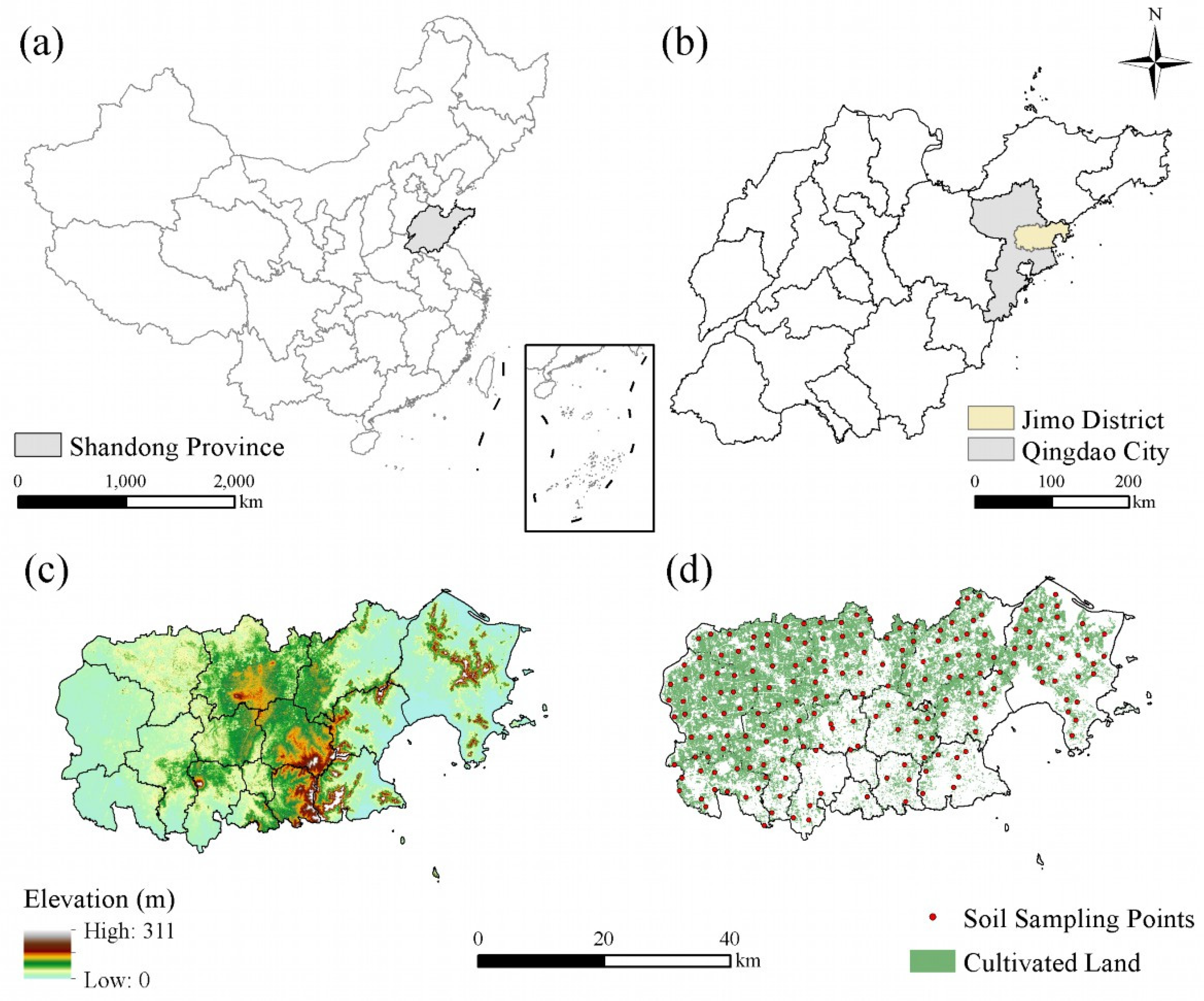

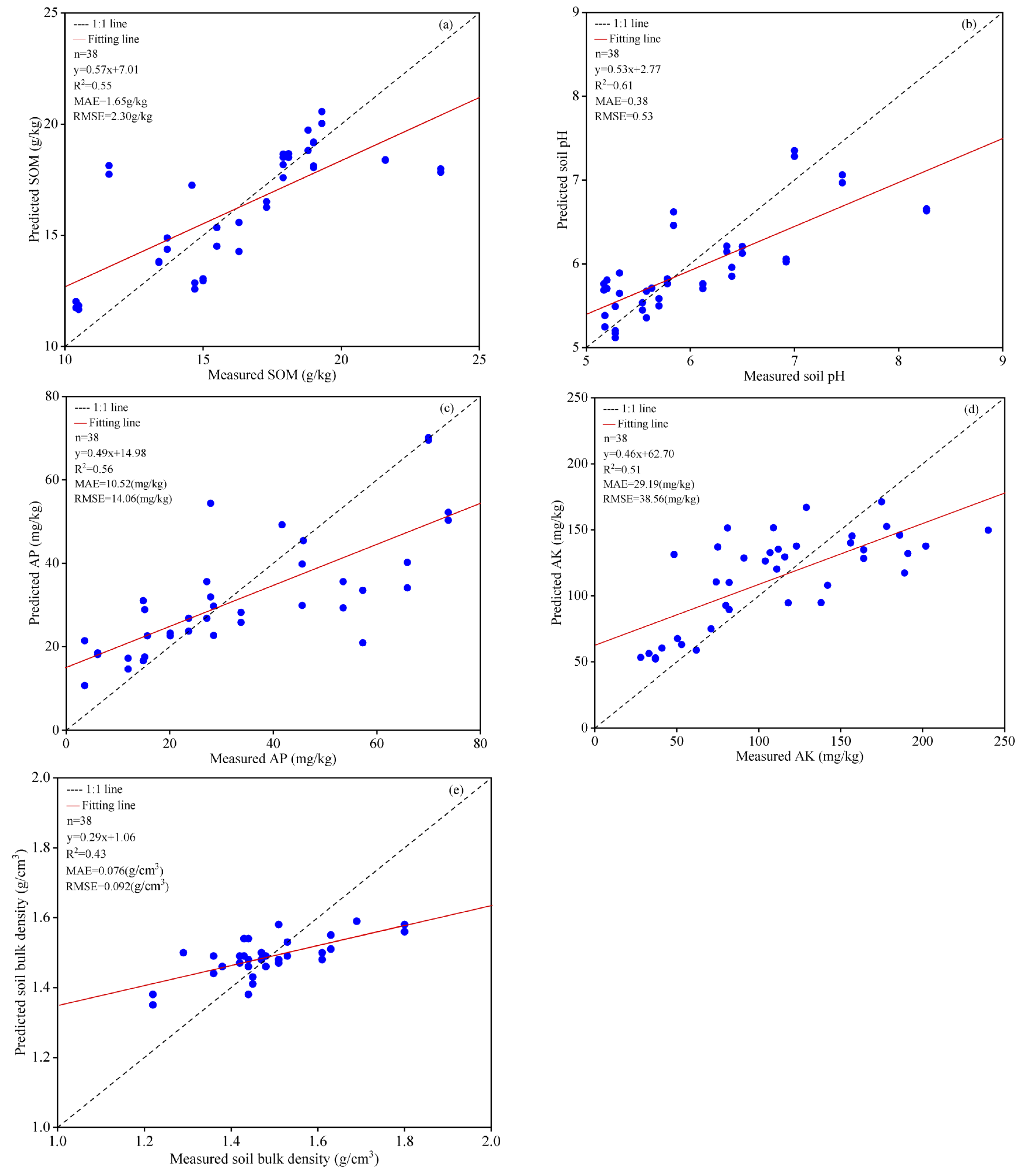
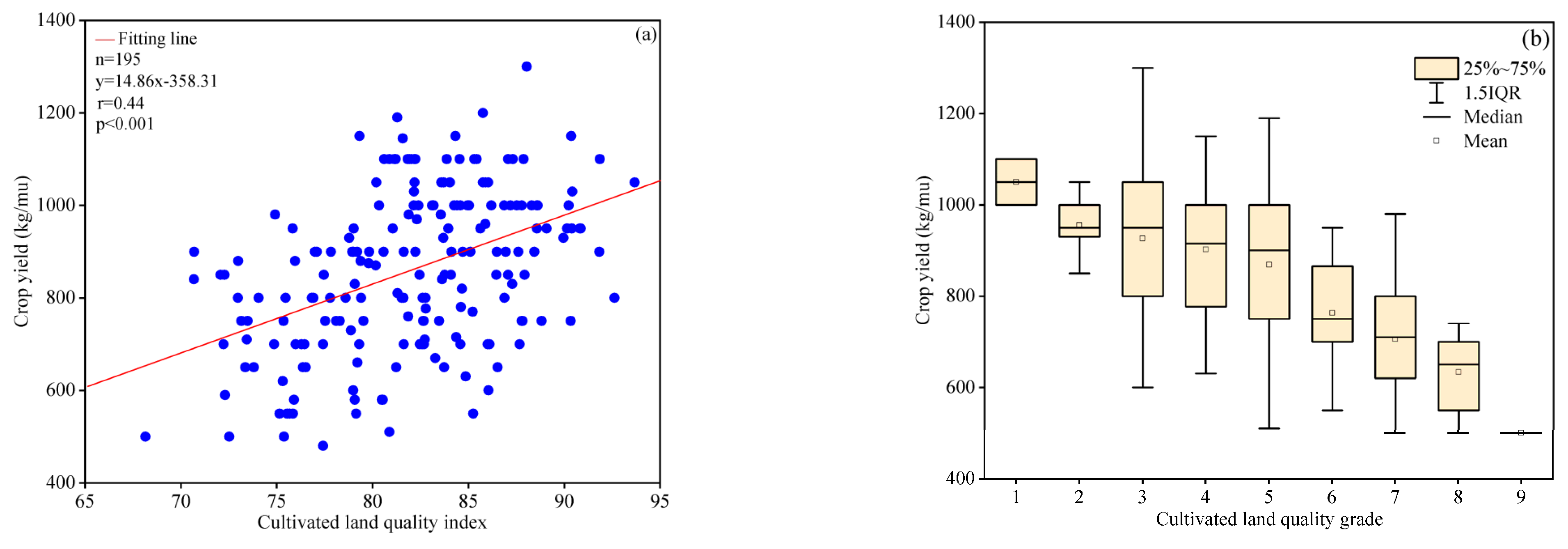
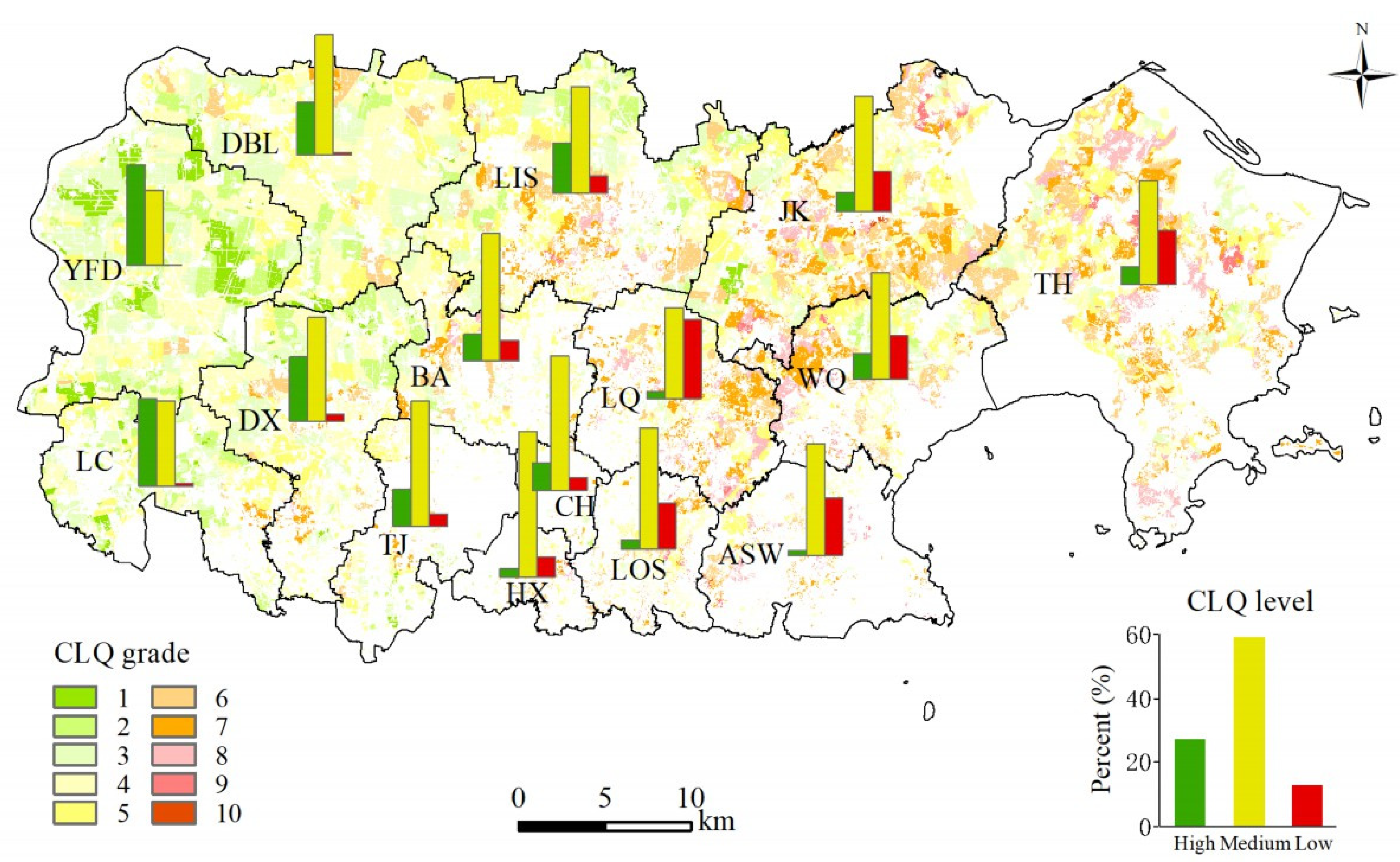
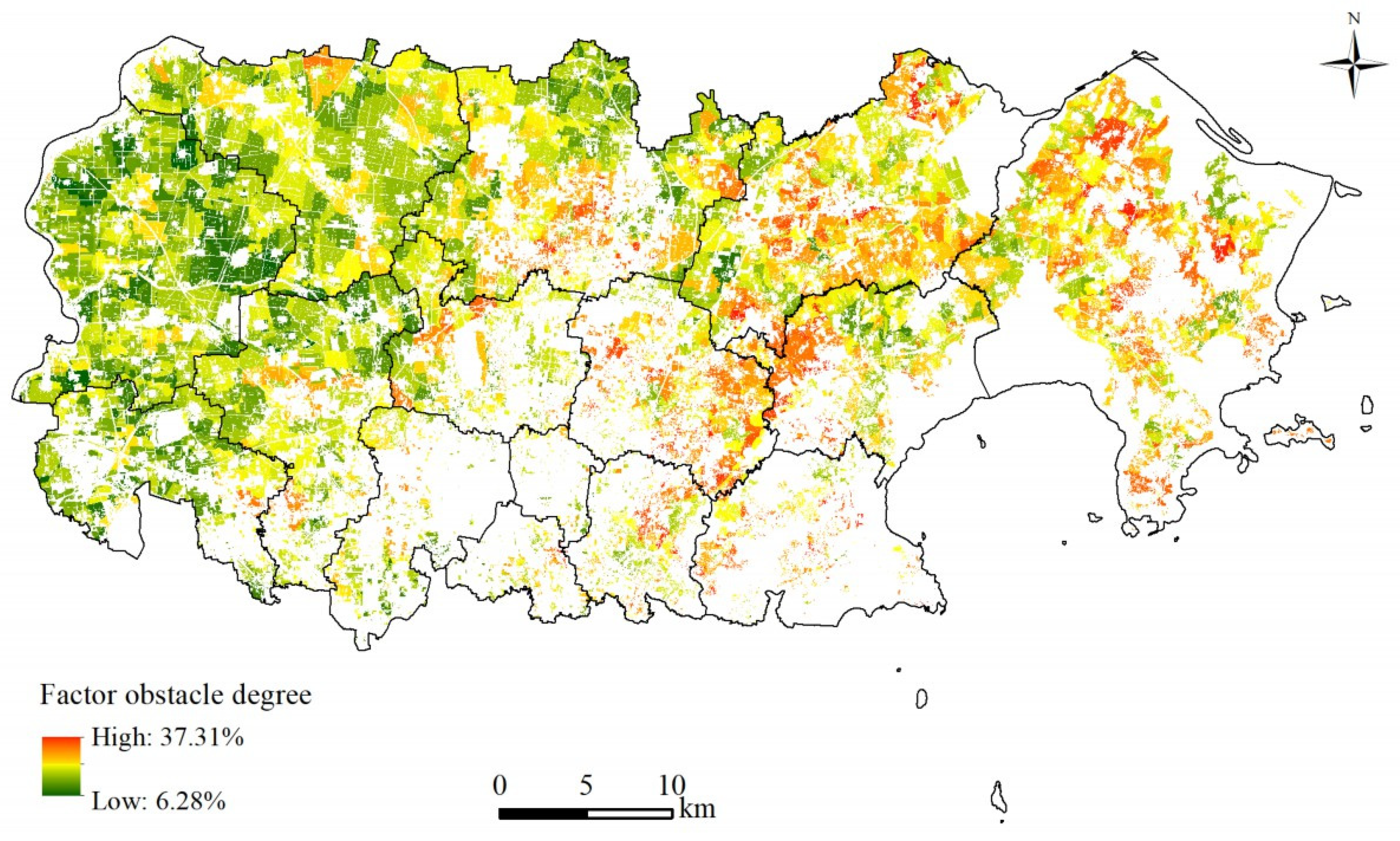
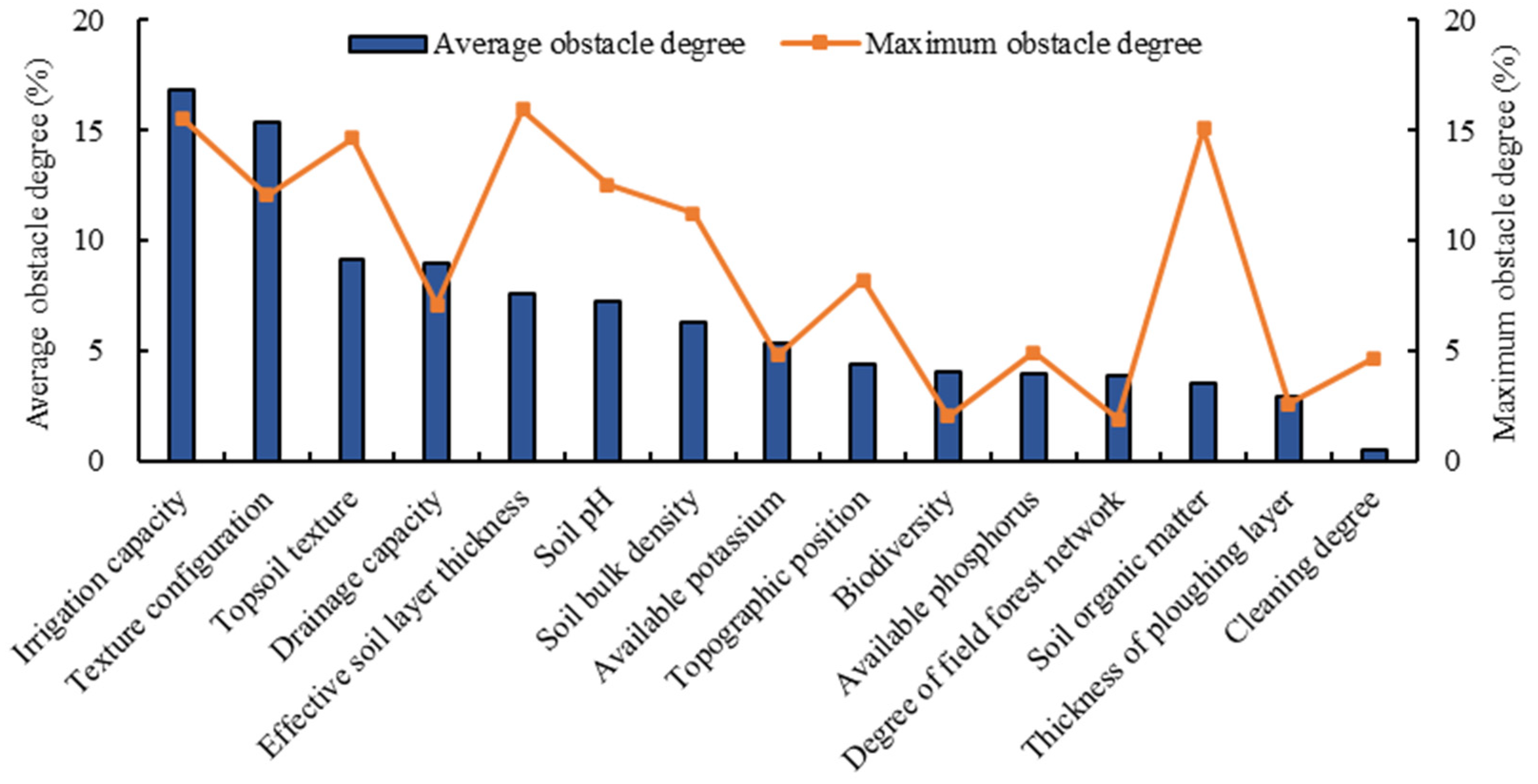
| Soil Organic Matter (g/kg) | Soil pH | Available Phosphorus (mg/kg) | Available Potassium (mg/kg) | Soil Bulk Density (g/cm3) | |
|---|---|---|---|---|---|
| n | 195 | 195 | 195 | 195 | 195 |
| mean | 14.98 | 5.89 | 38.43 | 105.28 | 1.48 |
| min | 4.09 | 2.86 | 3.60 | 19.00 | 1.11 |
| max | 30.70 | 8.32 | 225.20 | 280.00 | 1.81 |
| std. dev | 4.52 | 0.86 | 27.18 | 52.92 | 0.13 |
| variance | 20.43 | 0.73 | 738.70 | 2800.93 | 0.016 |
| cv (%) | 30.17 | 14.60 | 70.73 | 50.27 | 8.78 |
| Objective | Criterion | Indicator | Weight Coefficient |
|---|---|---|---|
| Cultivated land quality | Site condition | Topographic position | 0.102 |
| Effective soil layer thickness | 0.108 | ||
| Texture configuration | 0.075 | ||
| Thickness of ploughing layer | 0.039 | ||
| Physicochemical property | Soil pH | 0.063 | |
| Topsoil texture | 0.091 | ||
| Soil bulk density | 0.042 | ||
| Nutrient status | Soil organic matter | 0.096 | |
| Available phosphorus | 0.061 | ||
| Available potassium | 0.045 | ||
| Field management | Irrigation capacity | 0.116 | |
| Drainage capacity | 0.053 | ||
| Farmland forest network degree | 0.036 | ||
| Health status | Biodiversity | 0.038 | |
| Cleaning degree | 0.035 |
| Indicator | Function Type | Function | Lower Limit Value of u | Upper Limit Value of u |
|---|---|---|---|---|
| SOM | top | y = 1/(1 + 0.0054 × (u − 18.22)2) | 0 | 18.22 |
| AP | top | y = 1/(1 + 0.00001 × (u − 277.30)2) | 2 | 277.30 |
| AK | top | y = 1/(1 + 0.000067 × (u − 82.01)2) | 0 | 82.01 |
| Soil pH | Peak | y = 1/(1 + 0.17 × (u − 6.97)2) | 2 | 11.0 |
| SBD | Peak | y = 1/(1 + 6.75 × (u − 1.24)2) | 0.1 | 2.4 |
| Thickness of ploughing layer | top | y = 1/(1 + 0.0061 × (u − 22.66)2) | 0 | 22.66 |
| Effective soil layer thickness | top | y = 1/(1 + 0.00013 × (u − 126.65)2) | 0 | 126.65 |
| Indicator | Attribute | Membership Degree |
|---|---|---|
| Topographic position | Lower plain terrace | 1.00 |
| Broad valley basin | 0.95 | |
| Intermontane basin | 0.90 | |
| Middle plain terrace | 0.87 | |
| Upper plain terrace | 0.80 | |
| Lower part of hill | 0.70 | |
| Middle part of hill | 0.50 | |
| Upper part of hill | 0.40 | |
| Lower part of mountain slope | 0.40 | |
| Middle part of mountain slope | 0.30 | |
| Upper part of mountain slope | 0.20 | |
| Texture configuration | Upper loose lower tight | 1.00 |
| Spongy | 0.90 | |
| Upper tight lower loose | 0.88 | |
| Compact | 0.85 | |
| Sandwich | 0.68 | |
| Loose | 0.65 | |
| Thin layer | 0.40 | |
| Topsoil texture | Medium loam | 1.00 |
| Light loam | 0.85 | |
| Heavy loam | 0.80 | |
| Sandy loam | 0.70 | |
| Clay soil | 0.50 | |
| Sandy soil | 0.40 | |
| Irrigation capacity | Fully satisfied | 1.00 |
| Satisfied | 0.85 | |
| Basically satisfied | 0.70 | |
| Not satisfied | 0.50 | |
| Drainage capacity | Fully satisfied | 1.00 |
| Satisfied | 0.85 | |
| Basically satisfied | 0.70 | |
| Not satisfied | 0.50 | |
| Degree of field forest network | High | 1.00 |
| Middle | 0.80 | |
| Low | 0.60 | |
| Biodiversity | Abundant | 1.00 |
| General | 0.80 | |
| Deficient | 0.40 | |
| Cleaning degree | Cleaning | 1.00 |
| Still cleaning | 0.70 | |
| Light pollution | 0.50 |
| Type | Feature | SOM | pH | AP | AK | SBD | Data Source |
|---|---|---|---|---|---|---|---|
| Remote sensing (Sentinel-2 image) | B2 band reflectance | √ | https://www.usgs.gov/ (accessed on 1 May 2023) | ||||
| B3 band reflectance | √ | √ | √ | √ | √ | ||
| B4 band reflectance | √ | √ | √ | ||||
| B5 band reflectance | |||||||
| B6 band reflectance | |||||||
| B7 band reflectance | √ | ||||||
| B8 band reflectance | √ | √ | √ | ||||
| B8a band reflectance | √ | ||||||
| NDVI | √ | ||||||
| EVI | √ | √ | |||||
| SAVI | √ | ||||||
| Climate | Mean annual temperature | √ | √ | √ | http:/data.cma.cn/ (accessed on 10 May 2023) | ||
| Mean annual precipitation | √ | √ | √ | √ | |||
| Accumulated temperature greater than 10 degrees Celsius | √ | √ | |||||
| Relative humidity | √ | √ | √ | √ | |||
| Evaporation | √ | √ | √ | √ | √ | ||
| Terrain | Altitude | √ | √ | √ | http://www.gscloud.cn/ (accessed on 28 May 2023) | ||
| Slope | √ | √ | √ | √ | |||
| Plane curvature | √ | √ | √ | ||||
| Profile curvature | √ | √ | |||||
| Topographic wetness index | √ | √ | √ | √ | √ | ||
| Soil property | Cation exchange capacity | √ | √ | √ | √ | √ | Field survey data |
| Soil moisture content | √ | √ | √ | √ | |||
| Soil silt content | √ | √ | √ | √ | |||
| Soil sand content | √ | √ | √ | √ | |||
| Soil clay content | √ | √ | √ | √ | |||
| Land use | Cultivated land type | √ | Field survey data | ||||
| Cropping system |
| Model | Parameter | SOM | pH | AP | AK | SBD |
|---|---|---|---|---|---|---|
| RF | max_depth | 20 | 20 | / | 60 | / |
| n_estimators | 80 | 60 | / | 80 | / | |
| min_samples_split | 2 | 2 | / | 1 | / | |
| min_samples_leaf | 1 | 1 | / | 1 | / | |
| max_leaf-nodes | 1 | 1 | / | 2 | / | |
| AdaBoost | max_depth | / | / | 30 | / | 50 |
| n_estimators | / | / | 50 | / | 30 | |
| learning_rate | / | / | 0.001 | / | 0.001 |
| CLQ grade | Area (hm2) | Precent (%) | |
|---|---|---|---|
| High-quality | 1 | 2344.62 | 2.99 |
| 2 | 6110.55 | 7.80 | |
| 3 | 13,034.11 | 16.64 | |
| Medium-quality | 4 | 22,267.29 | 28.42 |
| 5 | 14,026.51 | 17.91 | |
| 6 | 10,214.59 | 13.04 | |
| Low-quality | 7 | 6489.59 | 8.28 |
| 8 | 3286.94 | 4.20 | |
| 9 | 528.06 | 0.67 | |
| 10 | 35.65 | 0.05 | |
| Total | 78,337.91 | 100 | |
| Average CLQ index | 82.14 | ||
| Average CLQ grade | 4.48 | ||
Disclaimer/Publisher’s Note: The statements, opinions and data contained in all publications are solely those of the individual author(s) and contributor(s) and not of MDPI and/or the editor(s). MDPI and/or the editor(s) disclaim responsibility for any injury to people or property resulting from any ideas, methods, instructions or products referred to in the content. |
© 2024 by the authors. Licensee MDPI, Basel, Switzerland. This article is an open access article distributed under the terms and conditions of the Creative Commons Attribution (CC BY) license (https://creativecommons.org/licenses/by/4.0/).
Share and Cite
Duan, D.; Li, X.; Liu, Y.; Meng, Q.; Li, C.; Lin, G.; Guo, L.; Guo, P.; Tang, T.; Su, H.; et al. County-Level Cultivated Land Quality Evaluation Using Multi-Temporal Remote Sensing and Machine Learning Models: From the Perspective of National Standard. Remote Sens. 2024, 16, 3427. https://doi.org/10.3390/rs16183427
Duan D, Li X, Liu Y, Meng Q, Li C, Lin G, Guo L, Guo P, Tang T, Su H, et al. County-Level Cultivated Land Quality Evaluation Using Multi-Temporal Remote Sensing and Machine Learning Models: From the Perspective of National Standard. Remote Sensing. 2024; 16(18):3427. https://doi.org/10.3390/rs16183427
Chicago/Turabian StyleDuan, Dingding, Xinru Li, Yanghua Liu, Qingyan Meng, Chengming Li, Guotian Lin, Linlin Guo, Peng Guo, Tingting Tang, Huan Su, and et al. 2024. "County-Level Cultivated Land Quality Evaluation Using Multi-Temporal Remote Sensing and Machine Learning Models: From the Perspective of National Standard" Remote Sensing 16, no. 18: 3427. https://doi.org/10.3390/rs16183427
APA StyleDuan, D., Li, X., Liu, Y., Meng, Q., Li, C., Lin, G., Guo, L., Guo, P., Tang, T., Su, H., Ma, W., Ming, S., & Yang, Y. (2024). County-Level Cultivated Land Quality Evaluation Using Multi-Temporal Remote Sensing and Machine Learning Models: From the Perspective of National Standard. Remote Sensing, 16(18), 3427. https://doi.org/10.3390/rs16183427






